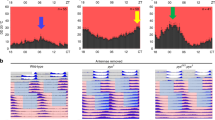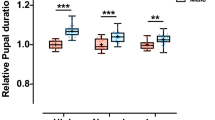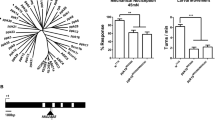Abstract
The Drosophila melanogaster male produces a species-specific courtship song by wing vibration. The most conspicuous feature of the song is a series of pulses with a 30–40-ms interpulse interval (IPI)1,2 which oscillate in wild-type males with a period of 50–60 s (ref. 3). This short-term biological rhythm in IPI is influenced by several gene mutations at the period (per) locus, which alter the normal 24-h free-running period of the circadian clock4 and have corresponding effects on the song cycle3. The present study reveals that, under restrictive conditions, temperature-sensitive mutations which affect neuronal membrane excitability seem to stop the biological clock underlying the fruitfly's song rhythm.
This is a preview of subscription content, access via your institution
Access options
Subscribe to this journal
Receive 51 print issues and online access
$199.00 per year
only $3.90 per issue
Buy this article
- Purchase on Springer Link
- Instant access to full article PDF
Prices may be subject to local taxes which are calculated during checkout
Similar content being viewed by others
References
Ewing, A. W. & Bennett-Clark, H. C. Behaviour 31, 287–301 (1968).
von Schilcher, F. Anim. Behav. 24, 18–26 (1976).
Kyriacou, C. P. & Hall, J. C. Proc. natn. Acad. Sci. U.S.A. 77, 6729–6733 (1980).
Konopka, R. & Benzer, S. Proc. natn. Acad. Sci. U.S.A. 68, 2112–2116 (1971).
Wu, C. F., Ganetsky, B., Jan, L. Y., Jan, Y. N. & Benzer, S. Proc. natn. Acad. Sci. U.S.A. 75, 4047–4051 (1978).
Suzuki, D. T., Grigliatti, T. & Williamson, R. Proc. natn. Acad. Sci. U.S.A. 68, 890–893 (1971).
Wu, C. F. & Ganetzky, B. Nature 28, 814–816 (1980).
Kimura, J. E. & Meves, H. J. Physiol., Lond. 289, 479–500 (1979).
Sevcik, C. J. Physiol., Lond. 352, 187–194 (1982).
Fuzeau-Braesch, S. & Nicholas, N. Comp. Biochem. Physiol. 68 A, 289–297 (1981).
Clark, M. A. & Eaton, D. C. J. Neurobiol. 14, 237–250 (1983).
Pittendrigh, C. S. Proc. natn. Acad. Sci. U.S.A. 40, 1018–1029 (1954).
Saunders, D. S. Insect Clocks 2nd edn (Pergamon, Oxford, 1982).
Takahashi, J. S. & Zatz, M. Science 217, 1104–1111 (1982).
Jackson, F. R., Wilson, S. D., Strichartz, G. R. & Hall, L. M. Nature 308, 189–191 (1984).
Kauvar, L. M. Molec. gen. Genet. 187, 172–173 (1982).
Hall, L. M., Wilson, S. D., Gischier, J., Martinez, N. & Strichartz, G. R. Ciba Fdn Symp. 88, 207–220 (1982).
Eskin, A. & Corrent, G. J. comp. Physiol. 117, 1–21 (1977).
Eskin, A. J. Neurobiol. 13, 241–249 (1981).
Eskin, A. J. Neurobiol. 8, 273–299 (1977).
Hall, J. C. in Results and Problems in Cell Differentiation Vol. 9 (ed. Gehring, W. J.) (Springer, Berlin, 1978).
Konopka, R., Wells, S. & Lee, T. Molec. gen. Genet. 190, 284–288 (1983).
Author information
Authors and Affiliations
Rights and permissions
About this article
Cite this article
Kyriacou, C., Hall, J. Action potential mutations stop a biological clock in Drosophila. Nature 314, 171–173 (1985). https://doi.org/10.1038/314171a0
Received:
Accepted:
Issue Date:
DOI: https://doi.org/10.1038/314171a0
This article is cited by
-
Female song preference and theperiod gene inDrosophila
Behavior Genetics (1993)
-
Drosophila courtship song cycles in normal andperiod mutant males revisited
Behavior Genetics (1990)
-
The molecular ethology of theperiod gene inDrosophila
Behavior Genetics (1990)
-
Spectral analysis ofDrosophila courtship songs:D. melanogaster, D. simulans, and their interspecific hybrid
Behavior Genetics (1988)
Comments
By submitting a comment you agree to abide by our Terms and Community Guidelines. If you find something abusive or that does not comply with our terms or guidelines please flag it as inappropriate.



